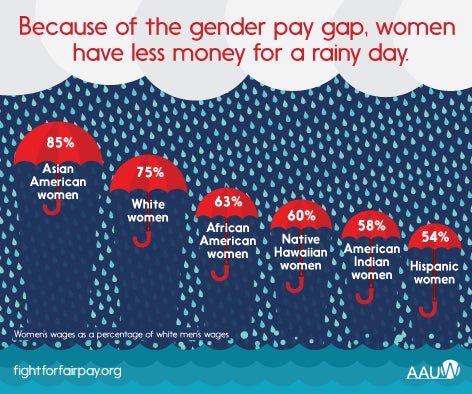
More and more people—from major publishers to my friends at brunch—are talking about the gender pay gap these days, which is great! The problem is, most people are focusing on the wrong things in these discussions. While people debate salary transparency vs. quotas to place women in upper management or discuss the merits of Salesforce’s approach, they’re missing the underlying problems—and the real measures it will take to fix them.
Let’s break this down. As you may already know, the gender pay gap is not equal for all women. Specifically:
1. Childless Caucasian women make $.96 to every $1 a man makes (achieving close to parity).
2. Caucasian mothers make $.71.
3. Black women (childless and mothers combined) make $.63.
4. Latina women (childless and mothers combined) make $.54.

So when we talk about the gender pay gap, what we are really talking about is two things: the motherhood penalty and the racial wage gap. If you are looking to close the gender pay gap you have to go after discrimination against mothers and women of color first.
It’s not just discrimination when it comes to pay. Mothers and women of color experience what is called stereotype threat—a psychological risk that results from negative stereotypes about women’s professional ability. Basically, if someone is in an environment where people expect them to underperform, it may actually lead them to underperform. So in a society or workplace culture that has underlying expectations women won’t perform as well as their male counterparts, these highly competent and motivated individuals may actually inadvertently start to reflect that. That’s not their fault. That is a failure of the system, a failure of the company, a failure of these women’s direct managers.
Let’s look at an example. When speaking to heads of HR or managers, I often hear something like, “Well this particular woman (often referring to a mother or woman of color) just wasn’t performing up to expectations. That was why she didn’t get a raise.”
I always ask: Why was that woman underperforming? Do you know? Was there something going on in the culture or team dynamics that systematically thwarted her ability to perform at her optimal level? Was there any overt or subtle discrimination against her that may have prevented her from succeeding? This could take the form of mentoring or sponsoring only people who look like you. When the dominant manager is a white Caucasian male, mothers and women of color may inadvertently get less mentorship and support. In a study done on developing multicultural competence for managers, researchers found one of the variables that impact the quality of manager-employee exchange is how similar they are in demographic attributes. The scientists found that individuals are more likely to view people who are demographically similar as members of the “in-group” and thus view these individuals as more attractive, trustworthy, honest, and cooperative than members of the “out-group.”
The researchers also noted that if you are part of the “out-group,” you could be perceived as less competent and less supported by your manager compared to your colleagues of “in-group.”
Other common examples of microaggressions that affect a woman’s ability to fully succeed include exclusion of women and people of color from important business conversations or insensitive microinsults that put down working women.
So where do we start with fixing this?
There is no silver bullet, but the first step is for leading professionals to stop spending time talking about transparent salaries and instead dive deeper to talk about the underlying issues. Leaders need to start understand the effect that subtle, unconscious microaggressions towards women has on those individuals, on workplace relationships, and even on their business productivity and success. Companies and the employees who work for them have to be willing to look for patterns of inequality towards mothers and women of color, explore their unconscious biases, and be more prepared to take action to address these problems.
Hopefully, over time, this will help to mitigate on the effects of the stereotype threat, which will lead to more women thriving in their careers—and leave no excuses for corporations to pay them any less than their male counterparts.
I never said keeping women working was easy. I said it’s worth it.
